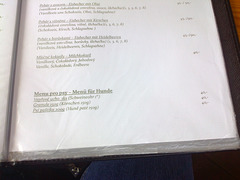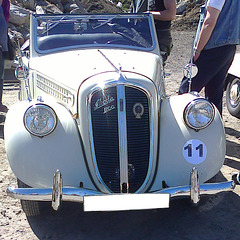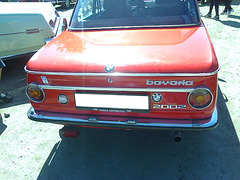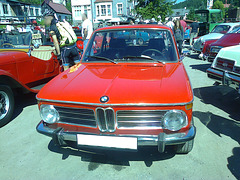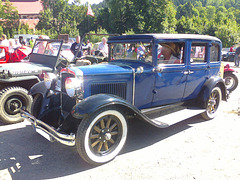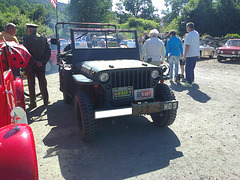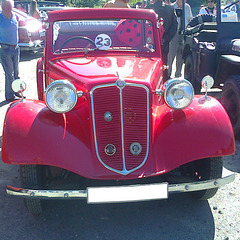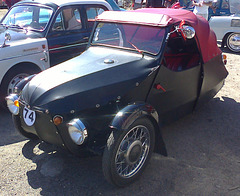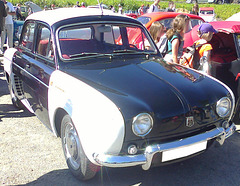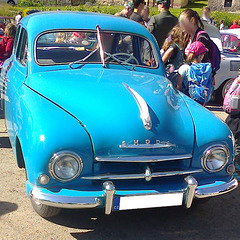Jon Searles' photos
Dog Menu at Cafe-Grill Promenada, Pec pod Snezkou,…
| |
|
This was the dog menu at Cafe-grill Promenada. This isn't actually the only time I've seen this in Czech restaurants, as most of them allow guests to bring their dogs.
Menu at Cafe-Grill Promenada, Pec pod Snezkou, Kra…
| |
|
This was the menu at Cafe-grill Promenada. There was a separate section in the menu for dogs.
Cafe-Grill Promenada, Pec pod Snezkou, Kralovehrad…
| |
|
Cafe-grill Promenada is a small cafe at the foot of Snezka, the tallest mountain in the Czech Republic at 1603 metres (5,260 feet) ASL. I was here with a friend before we took the cable car up the mountain in order to hike down.
foursquare.com/v/caf%C3%A9grill-promen%C3%A1da/4cc98e3646b43704b24249e1
BMW 3-series Race(?) Car at the Josefuv Dul Car Sh…
| |
|
It isn't clear whether this is a factory race car, but the lack of an "M" badge on the grill would suggest that car was prepped by its racing team (if it's even a real race car, and not a custom made to look like one). This version of the 3-series, the so-called E30, was produced for the 1982-1989 model years, and included the original M3, introduced in 1986.
Mercedes 300SL Roadster at the Josefuv Dul Car Sho…
| |
|
This car, perhaps confusingly, is a Mercedes Benz 300SL, but NOT a gullwing. It isn't even a coupe at all, but a roadster. It mechanically is otherwise the same, meaning that it would have been one of the fastest street-legal production cars of its day. Although I wasn't able to get the year of this one, the 300SL roadster was made in the 1957-1963 model years. 1957 was the only model year in which both the roadster and the "Gullwing" coupe were produced, with coupes being produced only in the years 1954-1957. There was, of course, the 300SLR Uhlenhaut Coupe, produced in only 2 examples for the 1955 sports car racing season. However, not being a "pure" 300SL, but a special 300SLR race car, it doesn't necessarily count.
In spite of being officially the fastest street-legal production car of its day, with a 263Km/h(163 m.p.h.) top speed, the 300SL was not outrageously complicated. The engine was a 2996cc Mercedes M198 SOHC I-6, that was only high-tech in that it was fuel-injected in time when virtually no production cars were unless they were diesels. The engine produced up to 240 horsepower in the 300SL, and 0-60 times in the 7 second range (I have also read some sources giving 0-60 times in the 5-second range).
Skoda (Popular?) 1100 at the Josefuv Dul Car Show,…
| |
|
Several Skodas over the years have carried the 1100 model number, usually denoting an estimate of the engine displacement in cc. This one, however, appears to be a Skoda Popular 1100, even though there isn't any "Popular" letting on the grille. I base this on the fact that it's a roadster, and the simple process of elimination. If someone can detail this further, please comment below.
If in fact this is a Skoda Popular 1100, these cars, as stated, came with the water-cooled 1089cc I-4, which for the basic 1100 model (and not the 1101) put out 30 horsepower. The layout was front/rear. This produced a top speed of 105km/h(65 m.p.h.), which was acceptable at the time. This version of the 1100 Popular was produced from 1938 until 1946, with production continuing even during World War II, albeit for the German occupiers and their allies.
BMW 2002 Rear View at the Josefuv Dul Car Show, Li…
| |
|
Here's a rear view of the 2002, showing the 2002 badging, but no sign of a performance package. It isn't clear whether the "Bavaria" is a real BMW badge, although it could have been a special edition of some kind. Again, if you know the answer, you can comment below.
BMW 2002 at the Josefuv dul Car Show, Liberecky kr…
| |
|
Also called the BMW 02, this car, in several body styles and trims, was produced from 1966 to 1977, with the most famous model being the 1973 2002 Turbo, which specifically came with the 1990cc M10 turbo I-4 engine.
The distinction between an 02 and a 2002 was that a 2002 came with some version of the 1990cc M10 engine, which when rounded, was a 2-liter displacement engine. Given that the specific car in these photos is badged as a 2002, it presumably is a "real" 2002 with the 1990cc engine. However, it isn't clear one way or the other whether this is a turbo.
The original 1973 2002 Turbo prototype had decals to this effect, but production 2002 Turbos didn't have them.
Although the 2002 Turbo had only modest performance, with a 7-second 0-60 time, and a top speed of 211km/h(131 m.p.h.), it was one of the most important cars for establishing BMW as a sports car brand. BMW had already been heading in this direction with the 2002tii in 1968, and the "New series" of sedans in 1966, which the 02 was a downsized version of. Having said this, the vast majority of BMW 2002's lacked either the tii or the turbo package.
Nash 400 at the Josefuv Dul Car Show, Liberecky kr…
| |
|
Although the Morgan +4+ may have been marginally rarer, this car was, by car, the biggest surprise of the show, to me. This was the first time I had seen a Nash of any year or model in the Czech Republic, and unless I see this one I again, I presume I'll never see one here again. For that matter, I've seen very few in the United States, other than a 1950's-era Nash Metropolitan that one of my friends had.
I have managed to confirm in photos that there's one other Nash 400 like this one located in Europe, specifically in Norway, but it would be unsurprising if these were the only two. Here's a photo of the one in Norway:
upload.wikimedia.org/wikipedia/commons/e/eb/1929_Nash_400%2C_Owner_J%C3%B8rgen_Simonsen_IMG_9332.JPG
The Nash 400 was produced, as far as I can tell, from 1929 until 1938, but there were a number of facelifts with new, streamline body styles in the years 1932-1938. Source material is a bit scarce online. This one appears to be one of the older, pre-1932 models, possibly a 1929.
Someone with more detailed or accurate history would help a lot to flesh out this picture caption.
I've also had trouble getting technical data on the Nash 400, but my understanding is that it usually came with an I-8 engine, which would have made it higher end than most cars of its day. The business strategy of Nash, according to Wikipedia, was to give the customer "more than he paid for."
I'm also aware that many Nashes were designed with fold-down seats so that they could be used as campers (although I don't know if this Nash had this). Interestingly, Tatra also included fold-down sleeping seats on the 603 (the Tatra 603, albeit not the interior, can be seen in other photos from this car show).
Willys-Overland MB Jeep at the Josefuv Dul Car Sho…
| |
|
It is a common misconception that the first-ever Jeep was this one, the Willys MB, but actually Willys-Overland had introduced the earlier MA model in 1940 for the United States Marine Corps. By the time U.S. ground forces were engaged in World War II, the MB was more or less the definitive model, meaning it is far better remembered today. Jeeps were actually produced by all the multiple U.S. auto manufacturers due to their military application and association with World War II (including well after the war, into the 1980's, when some "Jeep" branded vehicles had parts from Ford, GM, and Mopar). In World War II the other major Jeep manufacturers besides Willys-Overland were American Bantam and Ford. The Fords were classified as Ford GPW's, There were also subtle differences in the design, not only between Bantams, Fords, and Willys, but also between U.S. models, as opposed to lend-lease models sent to Britain and the Soviet Union.
All subsequent Jeeps of the more authentic variety (the CJ-2A, the M38, the CJ-3, the DJ-3, the M38A1, the CJ-5, the DJ-5, the M151, and the CJ-7, among many variants) are descended from the MB, even if the original MB's are rarely seen anymore outside of museums. However, in the Czech Republic, original MB's are relatively common in preservation. This is in spite of their playing little role in the Czech military. Their popularity with Czech collectors is probably more due to their association with Patton's Third Army, which ended up being the U.S. Army which liberated Czechoslovakia at the end of the World War II, at least in the West. Anyone who knows the history is aware that Czechoslovakia ended up under Communist control from February 1948 onward, so the Czech army ended up using either Soviet, or domestically-produced, vehicles until 1989.
Tatra 75 at the Josefuv Dul Car Show, Libereky kra…
| |
|
Introduced in 1933 to replace the earlier Tatra 54, the 75 was a larger alternative to the 57, and had a similar grille to the 57A introduced in 1936. The grille also resembled the one used on the Skoda Popular, although Tatra and Skoda were, in those days, unrelated. The Tatra 75, being a midsize car, could be ordered as 2-door sedan, a 2-door convertible, a 4-door sedan, or (allegedly) a 4-door convertible. It was also available as a 6-passenger limousine, although the limo had a stretched wheelbase (because, of course, the Tatra 75 was normally too small to be a limousine). The vast majority, however, were 2-door, and most survivors today being convertibles. A number of these have sportier bodywork from outside coachbuilders like Karosarna Bohemia. In general, my opinion is that the 2-door convertibles resemble Ford roadsters of the same era, especially given both the v-grille, and the side louvers on the good, which resemble the louvers used on Fords in the model years 1935-1936. In terms of performance, though, the Tatra 75 had nowhere close to the power of a V-8 Ford. Like other 1920's and 1930's Tatras, it had an air-cooled "boxer" engine, in this case a 1688cc flat-4 with 30 horsepower, mated to a 4-speed manual transmission. It could be said that the transmission was much sportier than the engine. The layout was front/rear, which made the 75 the last Tatra with this layout. The top speed of the Tatra 75 was published as 90Km/h (56 m.p.h.), which was average for the era.
Velorex Oskar at the Josefuv dul Car Show, Liberec…
| |
|
Originally introduced in 1945, and remaining in production until 1971, the Velorex Oskar was a three-wheeler inspired by the various three-wheel sports cars produced by Morgan (before they transitioned to building retro-styled four-wheel sports cars). Mechanically, the Oskar used various motorcycle powertrains over the years, generally from Jawa and Ceska Zbrojovka, but the performance was rarely impressive. Most of the motorcycle engines produced only about 6 horsepower, which wasn't enough for the car, in spite of its extremely light weight of 205-395kg. A typical top speed of an Oskar would be only about 30km/h (18 m.p.h.). The main selling point of the Oskar was its low price and minimalist design. The most unique feature may have been that its body panels were mostly leather, rather than metal, wood, or plastic. It is thought by automotive historians that the reason for the eventual failure of the Velorex Oskar in the Czech market (to the extent that markets existed under Communism) was that the East German Trabant 601 offered a more modern design, better safety and comfort, and a considerably higher level of performance.
Citroen 2CV at the Josefuv Dul Car Show, Liberecky…
| |
|
This was one of the more common cars at the show, albeit as vintage as the others. This is, of course, a Citroen 2CV, which has sometimes been claimed to be have been France's answer to the Ford Model T and the Volkswagen Beetle. It was, however, very different from either car, and did not achieve the same universal acceptance in other countries.
The 2CV was actually based on a Citroen prototype from 1936 called the TPV, that had initially not been pursued because of World War II and the German occupation of France (the 2CV had originally been planned for release at the Paris Motor Show in 1939, but this never happened). The TPV was developed in cooperation with the Michelin tire company, and this collaboration continued after the war. It was almost certainly because of this connection that the Citroen 2CV was the first mass-market car with radial tires, despite its cheap design and low performance.
The first official model year for the 2CV was 1948, but numerous improvements were added in the coming years, including radial tires in 1949. The original Citroen 2CV was so spartan and primitive that it was considered by many critics to be outdated when it was new, and many basic features had to be added later. For example, the 2CV didn't have a fuel gauge until 1963, as previously the fuel tank had been equipped with a dipstick. One exception to its primitive design specifications was its 4-speed manual transmission, in an era when most 4-speed transmissions were in sports cars.
The 2CV's "sardine can" sunroof may be seen by modern people as a luxury, but it was partly intended to allow oversize loads in the passenger compartment. In spite of its light overall weight and soft suspension, the 2CV could tolerate a relatively high center of gravity without tipping over, much like the Ford Model T and unlike the Beetle (obviously, do your research before attempting anything in real life).
The 2CV was very light (at 600 kg.), with a very soft suspension that was designed to cross a ploughed field without breaking a basket full of eggs in the passenger seat. This test was to ensure that it would be able to deal with the low quality of French roads in the years immediately after World War II (or for that matter, before World War II). Another design specification was that it had to achieve a fuel consumption of only 3 liters per 100 kilometers, which is equivalent to 80 mpg US. For comparison, the 2001 Toyota Prius managed about 55 mpg, according to EPA standards. The 2CV, unlike the Prius, wasn't a hybrid or a diesel, but achieved this high fuel economy by being very light, at 600 kg (1,323 lbs.), and by being extremely underpowered, with a 375cc, 9-horsepower, flat-twin engine. For comparison, the Ford Model T had a 2.9L I-4 engine that could put out 20-23 horsepower, depending on the year, and the Volkswagen Beetle initially had a 25-horsepower flat-4 of about 1200cc displacement. This wasn't necessarily a problem from the perspective of Citroen's design specification for the 2CV, as the target top speed was only 50km/h (31 m.p.h.). In the end, the finished 2CV could achieve about 65Km/h (40 m.p.h.). Again, for comparison, Ford Model T's could achieve 35-40 m.p.h., while Volkswagen Beetles could reach about 110 Km/h (70 m.p.h.) in their original form (even if later Beetles were much faster).
The 2CV, unusually for 1948, had a front/front layout, with the engine mounted longitudinally. This is an unusual arrangement by modern standards (to mount the engine longitudinally in a front-wheel-drive car), but Citroen had been using this design since the 1930's, when they had been one of the first companies to market large numbers of front-wheel-drive cars.
Perhaps the weirdest aspect of the 2CV's design was that, once 4-wheel-drive was offered as an option from 1960 onward, a second engine was added in the rear on the 4WD "Sahara" model, rather than a linkage being designed to power the rear wheels from the front differential. This may have been down to the engine not being powerful enough for both the front and rear wheels, but I haven't been able to determine in my research if Citroen openly admitted this.
Due to its popularity, the 2CV remained in production until 1990, making it one of the few cars to remain in production for over 40 years without a complete facelift.
Mini at Josefuv Dul Car Show
| |
|
This is obviously a Mini, but my knowledge of Minis and their history is somewhat limited. This doesn't appear to be an original 1959 model, as the grille doesn't seem to match, but that leaves the model years 1960-2000 to guess.
I'm not sure what else I should say, given how common and well-known these cars were. They have been called the original modern hatchbacks, not only for their 3-door body style, but also because they were front/front layout from the very beginning of production. They were originally produced by The British Motor Corporation, also known as BMC, and in the Mini's case trading under the old Austin brand name. In 1968, British Leyland took over production, maintaining it until 1986, and then production continued until 2000 under the Rover Group. In 2001, a completely new Mini design debuted under the supervision of BMW, and subsequent Minis have been more closely related to the 2001 model than the 2000 model.
Skoda 100 (or possibly 110 or 120s) Race Car at Jo…
| |
|
Although it's possible this is a factory-produced Skoda 120 S Rallye, the lack of a front spoiler (and simply the mathematical odds) suggest that this is actually a Skoda 100 or 110 that's been race prepped. I don't know a lot about it, but obviously if anyone knows more, then put it in the comments.
Martinsyde Quick Six Motorbike at the Josefuv Dul…
| |
|
This is another rare vehicle that, in this case, I had never heard of before. This is a 1922 Martinsyde Quick Six motorbike. These were very fast for any road vehicles of the time, capable of 130Km/h (80 m.p.h.). The 738cc V-twin engine could produce 22 horsepower, which was actually more than the Ford Model T's of the time, so it was mostly down to the power-to-weight ratio.
The Martinsyde company was originally founded in 1908 in Woking, Surrey, England to produce aircraft, but from 1919 they began producing motorbikes as well. This business turned out to be very short-lived, as although the motorbikes sold reasonably well, the factory in Woking burnt down in 1922. Bat Motor Manufacturing ended up buying Martinsyde, and ended up producing the last Martinsydes in 1924 and 1925 before focusing entirely on their own designs.
There were a number of other motorcycles/motorbikes at the Josefuv dul car show, but because I've never been very into motorcycles I rationed my time with them, and concentrated on car pictures.
Renault Dauphine at the Josefuv Dul Car Show, Libe…
| |
|
|
One could easily get the impression that the Josefuv dul car show was focused on rear-engine cars in the year that I attended, as there were more rear-engined cars (beyond Skodas) than I've ever seen in one place before. Oddly, I don't recall seeing the two most famous rear-engined models, namely the Volkswagen Beetle and the Porsche 911, represented, but I did get to see a lot of cars that were more obscure (to me, anyway).
The Renault Dauphine, seen here, wasn't so obscure outside of the United States. In spite of its obscurity in America, it was a very commercially successful car worldwide. Renault claim that they produced 2,150,738 Dauphines between 1956 and 1967, and actually managed some initial success in the U.S., with U.S. sales peaking in 1959 at 102,000 units.
Renault were so puzzled by the car's sudden drop in U.S. popularity after 1959 that they commissioned an internal study, which was subsequently misplaced for several years, and ultimately irrelevant by the time it was located.
An honest assessment, from an American perspective, would be that the Dauphine's obscenely slow acceleration, at 37 seconds 0-60 would have been the kiss of death in a market in which the Volkswagen Beetle was considered a slow car, with 0-60 m.p.h. times in the 17-28 second range, depending on the engine. For that matter, even the East German Trabant 601 was claimed to be capable of 32-second 0-60 times, and pre-war V-8 Fords could also beat the Dauphine very easily. By the 1960's, most American cars could get from 0 to 60 in well under 15 seconds, and a number of completely mainstream cars like the Chevy Impala and Ford Galaxie could achieve under 9 seconds. This is without muscle cars being taken into account.
In spite of the Dauphine being a very light car, at only 650kg (for comparison, the VW Beetle was around 800-840kg), the reason for its terrible performance was probably the 845cc "Ventour" I-4 engine, which only put out 27-36 horsepower. The optional 36 horsepower variant could achieve a 0-60 time of 30 seconds, which still wouldn't be competitive in the U.S. market. The fact that the Dauphine could top out at normal highway speeds of 112Km/h and 130Km/h, respectively, simply wasn't relevant if it was too hard to accelerate in U.S. traffic, in spite of a bizarre Road & Track article that claimed the opposite. The bottom line is that 37 seconds 0-60 is too slow.
Having said this, the Dauphine was quite successful in other markets, so much so that Renault ended up producing it at branch plants in 13 countries outside of France. As stated above, total production was 2,150,738, so in the end Renault didn't really need the U.S. market.
Skoda 1200 at Josefuv Dul Car Show, Liberecky kraj…
| |
|
Skoda produced the 1200 from 1952 to 1956 as either a 4-door sedan (seen here), a 2-door wagon (sometimes classified as a van), or a 4-door wagon. Although originally intended as a family car, it was also used as a fleet vehicle, most famously as an ambulance. The ambulances were obviously based on the wagon, with both the 2-door and the 4-door variants being used. These ambulances appeared in numerous Czech movies and TV shows, most notably the medical/paramedic show "Sanitka."
www.ceskatelevize.cz/ct24/sites/default/files/styles/scale_1180/public/images/1446937-125810.jpg?itok=Rk_84aSq
The 1200 wasn't blazing fast, being available only with a very conservative water-cooled 1213cc I-4 engine, in a front/rear layout, that produced only 35 horsepower. This made the Skoda 1200 less powerful than a Ford Model A. Having said this, it matched the Model A's top speed of 105Km/h (65 m.p.h.). Czech roads in the 1950's were allegedly so bad, though, that it's unlikely this lack of performance was much of a problem, even for an ambulance. The 1200 was replaced for the 1957 model year with the 1201, which was so similar that it's easy to confuse the two models. The 1201 survived until 1961, when it was effectively replaced by the Octavia and the 1202, which only came as a wagon.
Speaking of the close resemblence between the 1200 and 1201, if someone can determine that this is a 1201, I can correct the title and caption. I'm assuming that this is a 1200 because of the large divider on the split windshield (which also appears to include a radio antenna on this specific car), which was downsized on the 1201 (by appearances), and not usually chromed.

